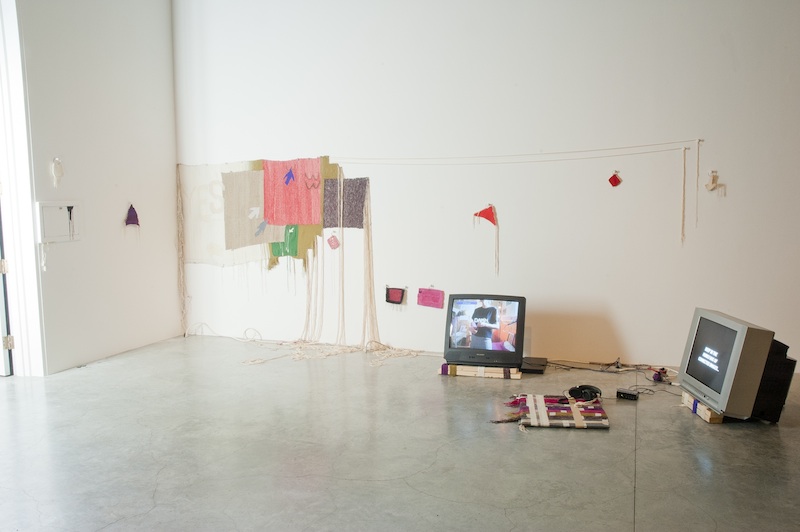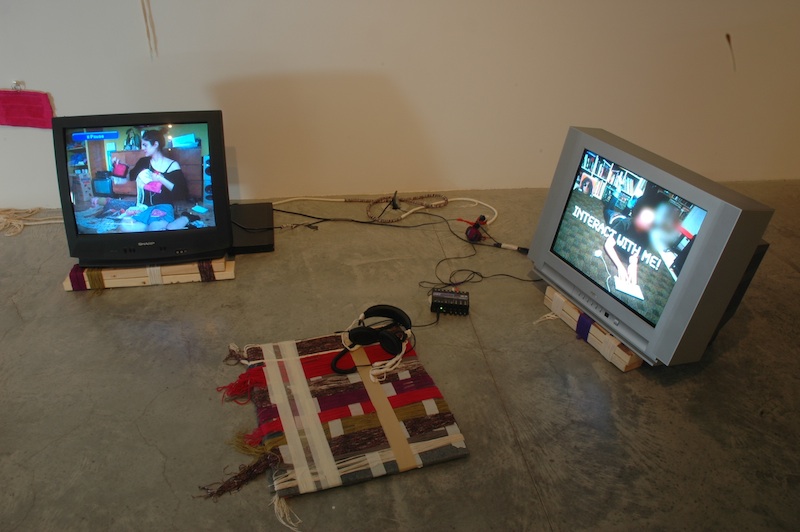Résumé
L’installation vidéo et textile de Wednesday Lupypciw produite en 2014 s’inscrit dans la poursuite des recherches de l’artiste sur le féminisme, le travail ainsi que l'économie liées aux pratiques du textile et à la technologie. Les personnages de Lupypciw habitent un récit vidéo fracturé, suivant l’évolution de l'invention d’Internet sous la forme qu'elle considère comme son «donjon sexuel imaginaire”. Avec un humour insolent, l’oeuvre se moque des pratiques intensives du travail et fétichistes retrouvées à la fois dans l'artisanat et les médias émergents. Elle propose une réalité alternative où le désir queer féministe devient une source d'impulsion pour créer, contrôler et profiter des espaces et des interactions en ligne.
Wednesday Lupypciw
BED OF INTIMACY (2014)
16:00 single-channel, Standard Definition video with ambient sound displayed as video installation with two synced monitors


My Sex Website (2014)
Tapestry installation with cotton, wool, silk, lurex, leather, wood and paint.
8’ x 15’ installed (variable)
photo credit: Stacey Watson
This work is included in a group exhibition titled In the making, curated by Diana Sherlock, that investigates conceptual intersections between contemporary craft and emerging digital media. The works in this exhibition span a diverse range of disciplines—photography, performance, video and sound installation, drawing, sculpture, ceramics, jewelry and glass. Together they reflect the ongoing influence of technology on ways of making and ways of thinking about the contemporary context. In its title, In the making alludes to the ongoing process of invention in both handwork and emerging technologies. The exhibition assumes the centrality of the processes of making to art, craft and design. It posits that technology and ways of making are not merely tools or processes required to get the job done, but are an integral conceptual extension of the project that allow the artist to produce objects and ideas they would not have been able to produce otherwise.
When the exhibition was presented at the Illingworth Kerr Gallery in January 2014, Lupypciw’s 16-minute video work was positioned at the entrance of the gallery, as part of a larger installation called My Sex Website (Figs. 1 and 2). The installation featured two TV monitors sitting on the floor alongside a hand-woven tapestry, and numerous fabric swatches hung from metal rings on the wall. Similar to Lupypciw’s past video works (http://wednesdaylupypciw.com/video/), BED OF INTIMACY uses split screens, mismatched voiceovers, and outdated equipment to piece together a humorous, fantastical, and multilayered work that simultaneously features the artist as director, editor, and actor(s). In Lupypciw's hands, video is treated as a raw material to be shaped and manipulated. As with any other craft medium, video is employed here for its inherent material qualities, glitches, and idiosyncrasies. This materialized approach is extended into the narrative of the video itself, where the characters turn the camera on one another to co-create customized spaces to suit their particular desires and bodies. In a reversal of patriarchal structures of control enacted or enforced in online communities, Lupypciw’s hands-on engagement with the medium works to undermine the power relations inherent in (online) surveillance.
In the video, a dominatrix struggles to find new and stimulating ways to please her client, and eventually enlists the help of her robot assistant to “build” the internet: an interconnected web of “sites” for her client to peruse. The work of building the sites and their connections is done laboriously by hand, using both basic and complex tools such as wrenches and looms. Each site or page is initially depicted as a hand-woven swatch of fabric (the same ones featured in the installation) – physical objects that can be handled, selected, and arranged at will. These very literal acts of making – alongside the woven objects that exist both within and outside of the video – make visible and tangible the labour and time involved in constructing online spaces.
By using the physical and tactile vocabulary of hand-making to address issues of online labour and authorship, Lupypciw links these ways of making together to argue for the internet as a (potential) site of female agency. If most current web content is still created by and for men, Lupypciw's cyber-women work against these traditionally gendered structures to build their own internet from scratch. Calling upon the feminist histories and politics of craft, these women are charged with creative autonomy and control over the processes, tools, and organization of the sites that they create and use. Here, crafting and craft labour become metaphors for the ways in which women and queers might not only invent, but also customize their own online spaces.
The characters in the video also reinforce the potential of these online spaces to be continuously adapted and improved by their users and creators. As the character of the client travels through the newly created web and visits each site in turn, he encounters a selection of men, dancing and posing provocatively—and embodying the content and style of each webpage. When he finally finds a “site” he likes, it is a space he declares as “safe” and where “the boundaries of our bodies collapse.” Rather than a disconnected or disembodied relationship between web content and users, those watching and those being watched, Lupypciw’s video ultimately argues for an optimistic and intimate view of a new feminist internet: a safe space for connection, communication, and desire.
Native de Calgary, Alberta, Wednesday Lupypciw pratique l’art de la vidéo et de la performance. Pour faire de l'argent, elle est femme de ménage à temps partiel. Elle poursuit également une pratique parallèle du textile - tissage, tricotage mécanique, broderie et crochet - réalisée la plupart du temps pendant qu’elle procrastine sur des projets de plus grande envergure. Le collectif d’art performatif LIDS (Ladies Invitational Deadbeat Society) fait partie de ses projets. Certaines de ses œuvres récentes ont été exposées lors de la Nuit Blanche de Calgary (2014), à La Centrale Galerie Powerhouse (Montréal, 2014), au FADO Performance Art Centre (Toronto, 2013), et dans l’exposition en tournée They Made A Day A Day Here (Grande Prairie, Saskatoon, Winnipeg, 2013), commissariée par Amy Fung.
Nicole Burisch est une commissaire, critique, artiste et travailleuse culturelle canadienne. La grande majorité de son travail porte sur l'artisanat contemporain et la théorie de l'artisanat. Elle a réalisé des recherches, publié, exposé et donné des conférences concernant ces sujets tant au Canada qu’à l'étranger. Ses recherches (avec Anthea Black), liées aux stratégies commissariales pour des pratiques artisanales politiquement engagées, ont été publiées dans The Craft Reader (Berg) et dans Extra/ordinary: Craft and Contemporary Art (Duke University Press). Les textes de Burisch ont également parus dans FUSE Magazine et les Cahiers métiers d’art :: Craft Journal, en plus d’avoir été publiés par la Stride Gallery et la Richmond Art Gallery. Burisch constitue le tiers du Ladies Invitational Deadbeat Society (LIDS), un groupe de tricot peu structuré, volontairement paresseux, dont les activités rendent visibles et politisent les rôles des femmes dans l’économie (de l’art).
Diana Sherlock est une commissaire indépendante, auteure et éducatrice canadienne. Ses projets engagent la recherche et la commande de modèles qui donnent l’occasion à des artistes contemporains de produire de nouvelles oeuvres en réponse à des collections, des contextes, des histoires et des cultures de présentation spécifiques. En plus de In the making, ses projets récents incluent Château Mathieu présentés à la Nickle Galleries de la University of Calgary (Alberta). Depuis 1995, Sherlock a publié plus de 50 textes dans des catalogues et des revues d'art contemporain, y compris Canadian Art, FUSE, Blackflash, Ceramics Art and Perception (Sydney, Australie), BorderCrossings, Artillery (Los Angeles / New York), CMagazine et The Calgary Herald. Sherlock a été commissaire en résidence au Alberta College of Art + Design (2011/2012) où elle enseigne la théorie critique et la pratique professionnelle à la School of Critical and Creative Studies.
